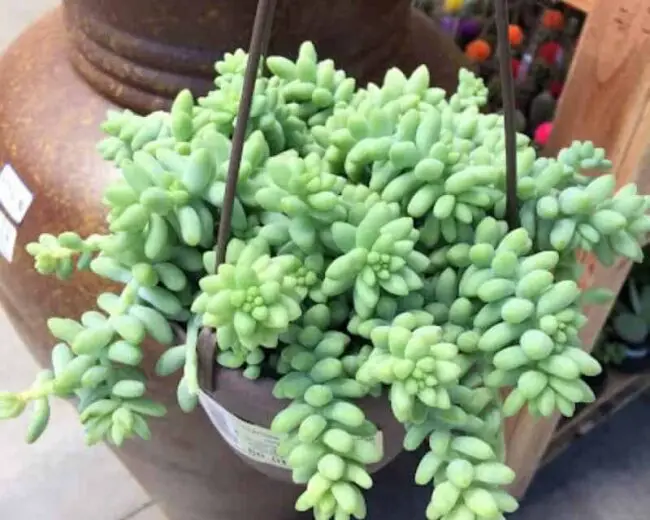Looking to keep your donkey tail plant happy and thriving? Wondering how to water the donkey tail plant to ensure its optimal growth? Well, you’ve come to the right place!
In this article, we will guide you through the simple and effective steps for watering your donkey tail plant, so you can provide it with the love and care it needs.
Let’s dive right in and explore how to water the donkey tail plant to keep it healthy and flourishing.
How to Water Donkey Tail Plant: A Comprehensive Guide
Donkey Tail (Sedum morganianum), also known as Burro’s Tail, is a popular trailing succulent plant that adds a touch of whimsy and beauty to any indoor or outdoor space.
With its delicate, cascading foliage and low-maintenance nature, it has become a favorite among succulent enthusiasts.
One crucial aspect of caring for a Donkey Tail plant is understanding its watering needs. Proper watering is essential to keep the plant healthy and thriving.
In this comprehensive guide, we will explore the various aspects of watering a Donkey Tail plant, including frequency, methods, signs of overwatering and underwatering, and much more. So, let’s dive in and learn how to water your Donkey Tail plant like a pro!
The Watering Needs of Donkey Tail Plant
Understanding the Natural Environment of Donkey Tail Plant
Before we delve into the specifics of watering, it’s important to understand the natural habitat of the Donkey Tail plant.
Native to Mexico, this succulent species typically grows in arid regions with minimal rainfall. In its natural environment, it adapts to survive in drought-like conditions and stores water in its fleshy leaves and stems.
Factors Affecting Watering Needs
To determine how frequently and how much to water your Donkey Tail plant, you need to consider a few factors that influence its watering needs:
- Climate
The climate of your location plays a significant role in watering requirements. Donkey Tail plants thrive in dry and warm conditions, so if you live in a region with high humidity or frequent rainfall, you might need to adjust your watering routine.
- Pot Size and Drainage
The size of the pot and the quality of its drainage system affect how quickly the soil dries out. Larger pots with proper drainage allow excess water to escape, preventing waterlogged soil.
- Soil Composition:
Well-draining soil is essential for Donkey Tail plants. Succulent-specific soil mixes or adding perlite or pumice to regular potting soil can improve drainage and prevent overwatering.
How to Water Donkey Tail Plant
Watering Frequency
Donkey Tail plants have moderate water requirements. While they can tolerate periods of drought, it’s crucial to avoid overwatering. Here’s a general guideline for watering frequency:
- Spring and Summer
During the active growing season (spring and summer), water your Donkey Tail plant every 7-10 days. This frequency allows the plant to absorb enough moisture while allowing the soil to dry out between waterings.
- Fall and Winter
As the plant enters its dormancy period, reduce watering frequency to once every 2-3 weeks. In cooler months, the plant requires less water to survive.
Watering Method
Proper watering technique is essential to prevent overwatering and ensure the roots receive adequate moisture. Follow these steps to water your Donkey Tail plant effectively:
- Check Soil Moisture
Before watering, check the moisture level of the soil by inserting your finger about an inch into the soil. Only water if the soil feels dry.
- Watering Amount
Water your Donkey Tail plant until you see water draining out from the bottom of the pot. This ensures thorough hydration and helps flush out any accumulated salts.
- Avoid Wetting the Leaves
Direct water flow towards the soil and avoid wetting the leaves. Wet foliage can lead to rot and fungal infections.
- Allow Proper Drainage
Ensure that the pot has drainage holes, allowing excess water to escape. Discard any water sitting in the saucer or tray beneath the pot after watering.
Signs of Overwatering and Underwatering
Signs of Overwatering
Overwatering can be detrimental to Donkey Tail plants, leading to root rot and eventual death. Keep an eye out for these signs of overwatering:
1. Yellowing or Dropping Leaves: Excessive moisture causes the leaves to turn yellow and eventually drop off.
2. Soft and Mushy Stems: If you notice soft and mushy stems or a foul odor coming from the soil, it is a sign of root rot caused by overwatering.
3. Pest Infestation: Overwatered plants are more susceptible to pests like fungus gnats and mealybugs.
Signs of Underwatering
While Donkey Tail plants are resilient and can tolerate dry conditions, underwatering can also have adverse effects. Look out for these signs of underwatering:
1. Wrinkled or Shriveled Leaves: Lack of water causes the leaves to shrivel and appear wrinkled.
2. Dry and Brittle Stems: Underwatered plants may exhibit dry and brittle stems, indicating dehydration.
3. Slow Growth: If your Donkey Tail plant shows stunted or slow growth, it may be a sign of inadequate water supply.
Tips for Watering Donkey Tail Plant
To ensure your Donkey Tail plant thrives and remains healthy, here are some additional tips for watering:
1. Consistency is Key: Maintain a consistent watering schedule to provide a stable environment for your plant. Avoid sudden fluctuations in watering frequency.
2. Avoid Standing Water: Donkey Tail plants dislike sitting in water. Ensure proper drainage in the pot to prevent waterlogging.
3. Monitor Seasonal Changes: Adjust your watering routine based on seasonal changes in temperature and daylight hours.
4. Be Mindful of Humidity: In high humidity areas, reduce watering frequency to prevent root rot.
5. Use Room Temperature Water: Avoid using very cold or very hot water. Room temperature water is ideal for Donkey Tail plants.
With these watering tips and techniques, you can keep your Donkey Tail plant healthy and thriving for years to come. Remember, succulents like the Donkey Tail adapt well to neglect, so it’s better to underwater than overwater. Observe your plant closely, and with time, you’ll develop a watering routine that suits its specific needs.
Remember, finding the right balance is key – water your Donkey Tail plant with confidence, but also give it the freedom to endure short periods of dryness. Enjoy the beauty of this remarkable succulent, and watch it flourish under your care!
Frequently Asked Questions (FAQs)
The donkey tail plant prefers to be watered thoroughly but infrequently. It is important to allow the soil to dry out completely between waterings.
As a general guideline, water the plant once every 2-3 weeks during the growing season, and reduce the frequency during winter months.
Tap water can contain chemicals like chlorine and fluoride, which can be harmful to the donkey tail plant. It is recommended to use filtered or distilled water to avoid any potential damage.
Alternatively, you can also leave tap water in an open container overnight to allow these chemicals to dissipate before using it to water your plant.
When watering your donkey tail plant, aim to thoroughly soak the soil until water drains out from the bottom of the pot.
Ensure that excess water is not left sitting in the saucer or container, as this can lead to root rot. It’s better to underwater than overwater, as the plant can tolerate slight drought conditions.
Misting the donkey tail plant is not necessary, as it prefers low humidity levels. In fact, excessive moisture on the leaves can cause them to rot. Focus on watering the soil rather than misting the foliage.
It is recommended to water your donkey tail plant in the morning, allowing ample time for any excess moisture to evaporate during the day. This helps prevent the plant from being overly damp for an extended period, minimizing the risk of fungal diseases.
Using a spray bottle to water your donkey tail plant can lead to inadequate hydration, as the water may not penetrate deep into the soil.
It’s best to use a watering can or pour water directly into the soil until it drains out from the bottom of the pot.
The donkey tail plant thrives in well-draining soil. A mixture of succulent/cactus potting mix and perlite or coarse sand works well. This type of soil allows excess water to drain quickly, preventing root rot.
Avoid using a self-watering pot for the donkey tail plant, as it can lead to overwatering.
These pots have a water reservoir at the bottom, which can cause the soil to remain continuously moist, increasing the chances of root rot. Opt for a regular pot with drainage holes instead.
Final Thoughts
To water a donkey tail plant, it is essential to find the right balance between under-watering and over-watering. The plant prefers a dry environment, so it is crucial not to overdo it with watering. Allow the soil to dry out completely between waterings, and then water thoroughly until water drains from the bottom of the pot.
Be cautious not to let the plant sit in standing water, as this can lead to root rot. Providing adequate water during the growing season and reducing watering in the winter will help the donkey tail plant thrive. Remember, when it comes to watering the donkey tail plant, moderation is key.
Auto Amazon Links: No products found.
Perfect Plants Christmas Tree Saver 8oz. | Easy Use Xmas Tree Preserver Food | Have Healthy Green Christmas Trees All Holiday Season
$9.97 (as of December 3, 2025 00:36 GMT +00:00 - More info- Product prices and availability are accurate as of the date/time indicated and are subject to change. Any price and availability information displayed on [relevant Amazon Site(s), as applicable] at the time of purchase will apply to the purchase of this product.
Kaiedos Christmas Tree Watering Funnel - 39 Inch Funnel, Reusable Design, Makes Watering Your Live Tree a Snap!
$14.99 (as of December 3, 2025 00:36 GMT +00:00 - More info- Product prices and availability are accurate as of the date/time indicated and are subject to change. Any price and availability information displayed on [relevant Amazon Site(s), as applicable] at the time of purchase will apply to the purchase of this product.
Christmas Tree Watering Funnel, Real Christmas Tree Water Long Funnel About 40 Inch, Trees Watering System for Water Indoor Outdoor
$15.99 (as of December 3, 2025 00:36 GMT +00:00 - More info- Product prices and availability are accurate as of the date/time indicated and are subject to change. Any price and availability information displayed on [relevant Amazon Site(s), as applicable] at the time of purchase will apply to the purchase of this product.
IPOOLTENG Christmas Tree Watering Funnel 3 Tube 1 Funnels 40 Inch - 3 Section Plastic Christmas Tree Funnel Waterer, Long Funnels for Watering Trees, Best Gifts for Your Parents to Water Tree
$15.53 (as of December 3, 2025 00:36 GMT +00:00 - More info- Product prices and availability are accurate as of the date/time indicated and are subject to change. Any price and availability information displayed on [relevant Amazon Site(s), as applicable] at the time of purchase will apply to the purchase of this product.
1 Pack Christmas Tree Watering Funnel System, 44 Inch Christmas Tree Watering Stick with Adjustable 3-Section Design, Reusable & Spill-Free, Xmas Plant Waterer Tool for Indoor and Outdoor
$16.99 (as of December 3, 2025 00:36 GMT +00:00 - More info- Product prices and availability are accurate as of the date/time indicated and are subject to change. Any price and availability information displayed on [relevant Amazon Site(s), as applicable] at the time of purchase will apply to the purchase of this product.
Cuisinart 6.5" Cast Iron Smashed Burger Press, Round Flat Edge Grill Press for Crispy Smash Burgers, Burger Tool for Grill and Griddle Accessories, for BBQs and Tailgates
$9.99 (as of November 30, 2025 15:21 GMT +00:00 - More info- Product prices and availability are accurate as of the date/time indicated and are subject to change. Any price and availability information displayed on [relevant Amazon Site(s), as applicable] at the time of purchase will apply to the purchase of this product.
Muddy Mat® Shown on TV Super Absorbent Microfiber Dog Door Mat for Muddy Paws, Non-Slip Washable Pet Rug, Quick Dry Chenille Entryway Carpet, Machine Washable Indoor Outdoor mat, Grey 30"x19"
$18.78 (as of November 30, 2025 15:21 GMT +00:00 - More info- Product prices and availability are accurate as of the date/time indicated and are subject to change. Any price and availability information displayed on [relevant Amazon Site(s), as applicable] at the time of purchase will apply to the purchase of this product.
Zevo Flying Insect Trap Official Refill Cartridges - Fits Both Zevo Trap & MAX Indoor Fly Trap - Authentic Trap+Lock Technology to Catch Gnats, House & Fruit Flys (4 Official Refill Cartridges)
$14.97 (as of November 30, 2025 15:21 GMT +00:00 - More info- Product prices and availability are accurate as of the date/time indicated and are subject to change. Any price and availability information displayed on [relevant Amazon Site(s), as applicable] at the time of purchase will apply to the purchase of this product.
ThermoPro TP16 Large LCD Digital Cooking Food Meat Thermometer for Smoker Oven Kitchen BBQ Grill Thermometer Clock Timer with Stainless Steel Temperature Probe
$17.99 (as of November 30, 2025 15:21 GMT +00:00 - More info- Product prices and availability are accurate as of the date/time indicated and are subject to change. Any price and availability information displayed on [relevant Amazon Site(s), as applicable] at the time of purchase will apply to the purchase of this product.
TERRO Ant Killer Bait Stations T300B - Liquid Bait to Eliminate Ants - Bait System - 12 Count Stations for Effective Indoor Ant Control
$10.86 (as of November 30, 2025 15:21 GMT +00:00 - More info- Product prices and availability are accurate as of the date/time indicated and are subject to change. Any price and availability information displayed on [relevant Amazon Site(s), as applicable] at the time of purchase will apply to the purchase of this product.











